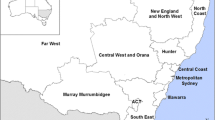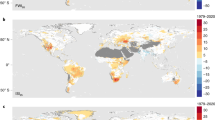Abstract
Global climate change, such as that due to the proposed enhanced greenhouseeffect, is likely tohave a significant effect on biosphere-atmosphere interactions, includingbushfire regimes. Thisstudy quantifies the possible impact of climate change on fire regimes byestimating changes infire weather and the McArthur Forest Fire Danger Index (FDI), an index thatis used throughoutAustralia to estimate fire danger. The CSIRO 9-level general circulation model(CSIRO9 GCM)is used to simulate daily and seasonal fire danger for the present Australianclimate and for adoubled-CO2 climate. The impact assessment includes validation ofthe GCMs daily controlsimulation and the derivation of ‘correction factors’ which improve theaccuracy of the firedanger simulation. In summary, the general impact of doubled-CO2is to increase firedanger at all sites by increasing the number of days of very high and extremefire danger.Seasonal fire danger responds most to the large CO2-induced changesin maximumtemperature.
Similar content being viewed by others
References
Allen-Diaz, B.: 1996, ‘Rangelands in a Changing Climate: Impacts, Adaptations and Mitigation’, in Watson, R. T., Zinyowera, M. C., and Moss, R. H. (eds.), Climate Change 1995: Impacts, Adaptations and Mitigation of Climate Change, Cambridge University Press, U.K., pp. 131–158.
Beer, T. and Williams, A. A. J.: 1995, ‘Estimating Australian Forest Fire Danger under Conditions of Doubled Carbon Dioxide Concentrations’, Clim. Change 29, 169–188.
Bergeron, J. and Flannigan M. D.: 1995, ‘Predicting the Effects of Climate Change on Fire Frequency in the Southern Canadian Boreal Forest’, Water Air Soil Pollut. 82, 437–444.
Bessie, W. C. and Johnson, E. A.: 1995, ‘The Relative Importance of Fuels and Weather on Fire Behaviour on Sub-Alpine Forests’, Ecology 76, 747–762.
Flannigan, M. D. and Van Wagner, C. E.: 1991, ‘Climate Change and Wildfire in Canada’, Can. J. Forest Res. 21, 66–72.
Fosberg, M. A., Stocks, B. J., and Lynham, T. J.: 1996, ‘Risk Analysis in Strategic Planning; Fire and Climate Change in the Boreal Forest’, in Goldammer, J. C. and Furyaev, V. V. (eds.), Fire in Ecosystems of Boreal Eurasia, Kluwer Academic Publishers, Dordrecht, pp. 495–505. 190 ALLYSON A. J. WILLIAMS ET AL.
Gill, A. M.: 1983, ‘Forest Fire and Drought in Eastern Australia’, in Proceedings of a Symposium on the Significance of El-Niño Southern Oscillation Phenomena and the Need for a Comprehensive Ocean Monitoring System for Australia, 27 and 28 July, Canberra, Australia.
Gill, A. M., Hoare, J. R. L., and Cheney, N. P.: 1990, ‘Fires and their Effects in the Wet-Dry Tropics of Australia’, in Goldammer, J. G. (ed.), Fire in the Tropical Biota, Springer-Verlag, p. 497.
Griffin, G. F., Price, N. F., and Portlock, H. F.: 1983, ‘Wildfires in Central Australia’, J. Environ. Manage. 17, 311–323.
IPCC, Intergovernmental Panel on Climate Change: 1996, Climate Change 1995: The Science of Climate Change, Houghton, J. T., Meira Filho, L. G., Callender, B. A., Harris, N., Kattenberg, A., and Maskell, K. (eds.), Cambridge University Press, U.K., p. 572.
Keetch, J. J. and Byram, G. M.: 1968, A Drought Index for Forest Fire Control, Research Paper E38, U.S. Department of Agriculture-Forest Service, Asheville, N.C., p. 32.
Kirschbaum, M. U. F. and Fischlin, A.: 1996, ‘Climate Change Impacts on Forests’, in Watson, R. T., Zinyowera, M. C., and Moss, R. H. (eds.), Climate Change 1995: Impacts, Adaptations and Mitigation of Climate Change, Cambridge University Press, pp. 95–130.
McArthur, A. G.: 1966. ‘Weather and Grassland Fire Behaviour’, Comm. Aust. Timb. Bur. Leaflet 100, 23.
McArthur, A. G.: 1967, ‘Fire Behaviour in Eucalypt Forest’, Comm. Aust. Timb. Bur. Leaflet 107, 25.
McGregor, J. L., Gordon, H. B., Watterson, I. G., Dix, M. R., and Rotstayn, L. D.: 1993, The CSIRO 9–Level Atmospheric General Circulation Model, CSIRO Division of Atmospheric Research, Technical Paper No. 26, CSIRO, Australia, p. 89.
Noble, I. R., Barry, G. A. V., and Gill, A. M.: 1980, ‘McArthur's Fire-Danger Meters Expressed as Equations’, Aust. J. Ecol. 5, 201–203.
Noble, J. C., Smith, A. W., and Leslie, H. W.: 1980, ‘Fire in the Mallee Shrublands of Western New South Wales’, Aust. Rangel. J. 2, 104–114.
Price, C. and Rind, C.: 1991, ‘Lightning Activity in a Greenhouse World’, in Proceedings of the 11th Conference on Fire and Forest Meteorology, 16–19 April 1991, Missoula, Montana, U.S.A., The Society of American Foresters, pp. 598–604.
Price, C. and Rind, C.: 1994, ‘Possible Implications of Global Climate Change on Global Lightning Distributions and Frequencies’, J. Geophys. Res. 99, 10823.
Stocker, G. C. and Mott, J. J.: 1981, ‘Fire in the Tropical Forests’, in Gill, A. M., Groves, R. H., and Noble, I. R. (eds.), Fire and the Australian Biota, Australian Academy of Science, Canberra, pp. 427–433.
Stocks, B. J., Fosberg, M. A., Lynham, T. J., Mearns, L., Wotton, B. M., Yang, Q., Zin, J-Z., Lawrence, K., Hartley, G. R., Mason, J. A., and McKenney, D. W.: 1998, ‘Climate Change and Forest Fire Potential in Russia and Canadian Boreal Forests’, Clim. Change 38, 1–13.
Swetnam, T. W.: 1993, ‘Fire History and Climate Change in Giant Sequoia Groves’, Science 262, 885–889.
Takle, E. S., Bramer, D. J., Heilman, W. E., and Thompson, M. R.: 1994, ‘A Synoptic Climatology for Forest Fires in the NE U.S. and Future Implications from GCM Simulations’, Int. J. Wildland Fire 4, 217–224.
Trabaud, L. V., Christensen, N. L., and Gill, A. M.: 1993, ‘Fire Biogeography: Temperate and Mediterranean’, in Crutzen, P. J. and Goldammer, J. G. (eds.), Fire in the Environment: The Ecological, Atmospheric and Climatic Importance of Vegetation Fire, Wiley.
Watterson, I. G., Dix, M. R., Gordon, H. B., and McGregor, J. L.: 1995, ‘The CSIRO Nine-Level Atmospheric General Circulation Model and Its Equilibrium Present and Doubled CO2 Climates’, Aust. Met. Mag. 44, 111–125.
Webb, L. J.: 1958, ‘Cyclones as an Ecological Factor in Tropical Lowland Rainforest, North Queensland’, Aust. J. Bot. 6, 220–228. THE SENSITIVITY OF AUSTRALIAN FIRE DANGER TO CLIMATE CHANGE 191
Whetton, P. H., Mullan, A. B., and Pittock, A. B.: 1996, ‘Climate Change Scenarios for Australia and New Zealand’, in Pearman et al. (eds.), Coping with Climate Change, CSIRO, Australia, pp. 145–168.
Williams, A. A. J. and Karoly, D. J.: 1999, ‘Extreme Fire Weather in Australia and the Impact of the El Niño-Southern Oscillation’, Aust. Met. Mag. 48, 15–22. (Received 31 March 1998; in revised form 31 July 2000)
Author information
Authors and Affiliations
Rights and permissions
About this article
Cite this article
Williams, A.A.J., Karoly, D.J. & Tapper, N. The Sensitivity of Australian Fire Danger to Climate Change. Climatic Change 49, 171–191 (2001). https://doi.org/10.1023/A:1010706116176
Issue Date:
DOI: https://doi.org/10.1023/A:1010706116176




